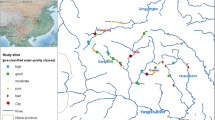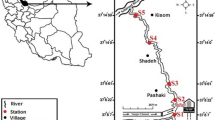Abstract
Specific conductivity is an increasingly important stressor for freshwater ecosystems. Interacting with other environmental factors, it may lead to habitat degradation and biodiversity loss. However, it is still poorly understood how the effect of specific conductivity on freshwater organisms is confounded by other environmental factors. In this study, a weight-of-evidence method was applied to evaluate the potential environmental factors that may confound the effect of specific conductivity on macroinvertebrate structure communities and identify the confounders affecting deriving conductivity benchmark in Hun-Tai River Basin, China. A total of seven potential environmental factors were assessed by six types of evidence (i.e., correlation of cause and confounder, correlation of effect and confounder, the contingency of high level cause and confounder, the removal of confounder, levels of confounder known to cause effects, and multivariate statistics for confounding). Results showed that effects of dissolved oxygen (DO), fecal coliform, habitat score, total phosphorus (TP), pH, and temperature on the relationship between sensitive genera loss and specific conductivity were minimal and manageable. NH3-N was identified as a confounder affecting deriving conductivity benchmark for macroinvertebrate. The potential confounding by high NH3-N was minimized by removing sites with NH3-N > 2.0 mg/L from the data set. Our study tailored the weighting method previously developed by USEPA to use field data to develop causal relationships for basin-scale applications and may provide useful information for pollution remediation and natural resource management.


Similar content being viewed by others
References
Achem, A. L. G., Rolandi, M. L., & Fernandez, H. R. (2015). Saline waters and macroinvertebrates in subtropical Andean streams. Ecologia Austral, 25, 26–35.
Barbour, M. T., Gerritsen, J., Snyder, B. D., & Stribling, J. B. (1999). Rapid bioassessment protocols for use in wadeable streams and rivers: periphyton, benthic macroinvertebrates and fish (2nd edn), Office of Water, U.S. Washington, DC: Environmental Protection Agency.
Bu, H., Meng, W., & Zhang, Y. (2014). Spatial and seasonal characteristics of river water chemistry in the Taizi River in Northeast China. Environmental Monitoring and Assessment, 186, 3619–3632.
Buss, D. F., & Vitorino, A. S. (2010). Rapid bioassessment protocols using benthic macroinvertebrates in Brazil: evaluation of taxonomic sufficiency. Journal of the North American Benthological Society, 29, 562–571.
Cañedo-Argüelles, M., Kefford, B. J., Piscart, C., Prat, N., Schäfer, R. B., & Schulz, C. J. (2013). Salinization of rivers: an urgent ecological issue. Environmental Pollution, 173, 157–167.
Cañedo-Argüelles, M., Bundschuh, M., Gutiérrez-Cánovas, C., Kefford, B. J., Prat, N., Trobajo, R., & Schäfer, R. B. (2014). Effects of repeated salt pulses on ecosystem structure and functions in a stream mesocosm. Science of the Total Environment, 476-477, 634–642.
Chapman, P. M., McDonald, D. G., & Lawrence, G. S. (2002). Weight-of evidence issues and frameworks for sediment quality (and other) assessments. Human and Ecological Risk Assessment, 8, 1489–1515.
Chessman, B. C. (1995). Rapid river assessment using macroinvertebrates: a procedure based on habitat-specific family-level identification and a biotic index. Austral Ecology, 20, 122–129.
Connolly, N. M., Crossland, M. R., & Pearson, R. G. (2004). Effect of low dissolved oxygen on survival, emergency, and drift on tropical stream macroinvertebrate. Journal of the North American Benthological Society, 23, 251–270.
Cormier, S. M., Paul, J. F., Spehar, R. L., Shaw-Allen, P., Berry, W. J., & Suter, G. W. (2008). Using field data and weight of evidence to develop water quality criteria. Integrated Environmental Assessment and Management, 4, 490–504.
Cormier, S. M., Wilkes, S. P., & Zheng, L. (2013). Relationship of land use and elevated ionic strength in Appalachian watersheds. Environmental Toxicology and Chemistry, 32, 296–303.
Gao, X., Niu, C., Chen, Y., & Yin, X. (2014). Spatial heterogeneity of stream environmental conditions and macroinvertebrates community in an agriculture dominated watershed and management implications for a large river (the Liao River, China) basin. Environmental Monitoring and Assessment, 186, 2375–2391.
Gao, X., Zhang, Y., Ding, S., Zhao, R., & Meng, W. (2015). Response of fish communities to environmental changes in an agriculturally dominated watershed (Liao River Basin) in northeastern China. Ecological Engineering., 76, 130–141.
Hill, A. B. (1965). The environment and disease: association or causation? Journal of the Royal Society of Medicine, 58, 295–300.
Kennedy, A. J., Cherry, D. S., & Currrie, R. J. (2004). Evaluation of ecologically relevant bioassays for a lotic system impacted by a coal-mine effluent, using Isonychia. Environmental Monitoring and Assessment, 95, 37–55.
Kimmel, W. G., & Argent, D. G. (2010). Stream fish community response to a gradient of specific conductance. Water Air and Soil Pollution, 206, 49–56.
Lechleitner, R. A., Cherry, D. S., Caims Jr., J., & Stetler, D. A. (1985). Ion regulatory and toxicological responses of stonefly nymphs (Plecoptera) to acidic and alkaline pH. Brazilian Archives of Biology and Technology, 14, 179–185.
Love, J. W., Taylor, C. M., & Warren, M. L. (2005). Predator density and dissolved oxygen affect body condition of Stenonema tripunctatum (Ephemeroptera, Heptageniidae) from intermittent streams. Hydrobiologia, 543, 113–118.
Lovett, S., Price, P., & Edgar, B. (2007). Salt, nutrient. Sediment and Interactions: Findings from the National River Contaminants Program, Land & Water Australia.
Mcneil, V. H., & Cox, M. E. (2007). Defining the climatic signal in stream salinity trends using the Interdecadal Pacific oscillation and its rate of change. Hydrology and Earth System Sciences, 3, 2963–2990.
Menetrey, N., Oertli, B., Sartori, M., Wagner, A., & Lachavanne, J. B. (2008). Eutrophication: are mayflies (Ephemeroptera) good bioindicators for ponds? Hydrobiologia, 597, 125–135.
Merritt, R. W., & Cummins, K. W. (2008). An introduction to the aquatic insects of North America (4rd ed.). Dubuque: Kendall Hunt Publishing Company Press.
Millennium Ecosystem Assessment. (2005). Ecosystems and human well-being: synthesis. Washington, DC: Island Press.
National Environmental Protection Bureau (NEPB). (2002). Standard methods for the examination of water and wastewater (4nd ed.). Beijing: China Environmental Science Publish Press (in Chinese).
Peter, G. T., Cherry, D. S., & Cairns Jr., J. (1985). Responses of Isonychia bicolor to alkaline pH: an evaluation of survival, oxygen consumption, and chloride cell ultrastructure. Canadian Journal of Fisheries and Aquatic Sciences, 42, 1088–1095.
Plafkin, J. L., Barbour, M. T., Porter, K. D., Gross, S. K., & Hughes, R. M. (1989). Rapid bioassessment protocols for use in streams and rivers: benthic macroinvertebrates and fish, EPA 444/4–89-001. DC, USA: U. S. Environmental Protection Agency. Washington.
Pond, G.J. (2004). Effects of surface mining and residential land use on headwater stream biotic integrity in the eastern Kentucky coalfield region. Kentucky Department of Environmental Protection, Division of Water, Frankfort, KY.
Puckett, R. T., & Cook, J. L. (2004). Physiological tolerance ranges of larval Caenis latipenniss (Ephemeroptera: Caenidae) in response to fluctuations in dissolved oxygen concentration, pH and temperature. The texas Journal of Science, 56, 123–130.
Rothman, K. J., Greenland, S., & Lash, T. L. (2008). Modern epidemiology (3nd ed). Philadelphia: Lippincott Williams & Wilkins.
Sonneman, J.A., Walsh, C.J., Breen, P.F., & Sharpe, A.K. (2001). Effects of urbanization on streams of the Melbourne region, Victoria, Australia. II: Benthic diatom communities. Freshwater Biology, 46, 553-565.
Suter, G. W., & Cormier, S. M. (2013). A method for assessing the potential for confounding applied to ionic strength in central Appalachian streams. Environmental Toxicology and Chemistry, 32, 288–295.
Thomas, A. G. (1986). Specific conductance as an indicator of total dissolved solids in cold, dilute waters. Hydrological Sciences Journal/journal Des Sciences Hydrologique, 31, 81–92.
United States Environmental Protection Agency (USEPA). (2008). Application of watershed ecological risk assessment methods to watershed management. Washington DC: USA.
United States Environmental Protection Agency (USEPA). (2011). A field-based aquatic life benchmark for conductivity in central Appalachian streams. Washington DC: USA.
United States Environmental Protection Agency (USEPA) (2010). WATERS (Watershed assessment, tracking results). Washington DC, USA.
Varnosfaderany, M. N., Ebrahimi, E., Mirghaffary, N., & Safyanian, A. (2010). Biological assessment of the Zayandeh Rud River, Iran, using benthic macroinvertebrates. Limnologica, 40, 226–232.
Williams, W. D. (1987). Salinization of rivers and streams: an important environmenta hazard. Ambio, 16, 181–185.
Williams, W. D., & Sherwood, I. (1994). Definition and measurement of salinity in salt lakes. International Journal of Salt Lake Research, 3, 53–63.
Wright, I. A., Moss, D., Armitage, P. D., & Furse, M. T. (1984). A preliminary classification of running water sites in Great Britain based on macroinvertebrate species and the prediction of community type using environmental data. Freshwater Biology, 14, 241–256.
Yu, T., Zhang, Y., Wu, F., & Meng, W. (2013). Six-decade change in water chemistry of large freshwater lake Taihu, China. Environmental Science and Technology, 47, 9093–9101.
Zalizniak, L., Kefford, B. J., & Nugegoda, D. (2009). Effects of pH on salinity tolerance of selected freshwater invertebrates. Aquatic Ecology, 43(1), 135–144.
Zhang, Y., Ding, S., Zhao, Q., Gao, X., Zhao, R., & Meng, W. (2015). Exploring the feasibility of establishing conductivity criteria for macroinvertebrate based on the field investigations. Asian Journal of Ecotoxicology, 10, 204–214 (in Chinese).
Zhang, Y., Guo, F., Meng, W., & Wang, X. (2009). Water quality assessment and source identification of Daliao river basin using multivariate statistical methods. Environmental Monitoring and Assessment, 152(1–4), 105–121.
Zhao, Q., Jia, X. B., Xia, R., Lin, J. N., & Zhang, Y. (2016). A field-based method to derive macroinvertebrate benchmark for specific conductivity adapted for small data sets and demonstrated in the Hun-Tai River Basin, Northeast China. Environmental Pollution, 216, 902–910.
Acknowledgements
This research was financially supported by the National Water Pollution Control and Management Technology Major Projects (2012ZX07501001) and the National Natural Science Foundation of China (Grant No. 41571050). We thank Dr. Rui Xia for the assistance with the manuscript preparation and valuable comments.
Author information
Authors and Affiliations
Corresponding author
Electronic supplementary material
ESM 1
(DOCX 30 kb)
Rights and permissions
About this article
Cite this article
Jia, X., Zhao, Q., Guo, F. et al. Evaluation of potential factors affecting deriving conductivity benchmark by utilizing weighting methods in Hun-Tai River Basin, Northeastern China. Environ Monit Assess 189, 97 (2017). https://doi.org/10.1007/s10661-017-5802-0
Received:
Accepted:
Published:
DOI: https://doi.org/10.1007/s10661-017-5802-0




